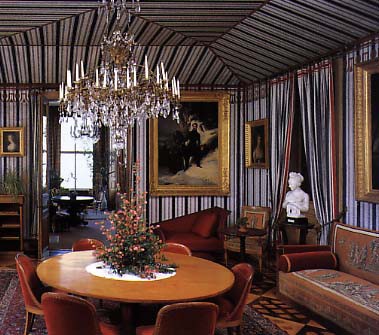Arenenberg Palace in the canton of Thurgovie was purchased in 1817 by the (at that time) exiled Queen Hortense. She spent every summer there from 1823 until the year of her death in 1837. Prince Louis-Napoleon spent his youth in Arenenberg, dividing his time between this charming residence and his studies in Augsburg. Forced to put the house up for sale after his mother's death, he was fortunate enough to become its owner once again in 1855 when the Empress Eugénie, to his great surprise, bought it back for him. He visited it one last time in 1865 as Count de Pierrefonds.
After 1873, the Empress and the Imperial Prince brought the palace back to life by making regular summer visits, which they continued until 1878. However, on the tragic death of her son in 1879, Eugénie found it difficult to return to a place so full of painful memories. And so in 1906 she donated the estate to the canton of Thurgovie as a testimony of her gratitude for the region's faithful hospitality towards the Napoleon family. And in accordance with the Empress' wishes, the residence was turned into a museum devoted to Napoleon.
Arenenberg palace overlooks the lower part of Lake Constance and, at first, appears a relatively modest country house. It nevertheless conceals within it incredible treasures, such as First-Empire, Biedermeier and Second-Empire furniture and ornamentation, and an important art collection including works by the First-Empire artists Chinard Canova, Gros, Robert Lefèvre, Gérard, Isabey and Girodet-Trioson, and by the Second-Empire painters and sculptors Alfred de Dreux, Winterhalter, Carpeaux, Meissonier, Hébert, Flandrin, Detaille, Nieuwerkerke and Giraud.
The alterations made first by Queen Hortense and later by Empress Eugénie have been carefully preserved and the house still bears the marks of both women. Queen Hortense's drawing room is perfectly preserved and visitors can still admire her magnificent library (all marked with the Empress' cipher) containing over one thousand books. Likewise, in the room where the queen died, every object has been maintained in its original condition: pieces of furniture and personal belongings are gathered here to evoke her memory in a very touching manner. As for Empress Eugénie's rooms, they too have been very carefully preserved. Her private drawing room is a perfect illustration of the Second Empire style with sculptures by Carpeaux and portraits of the imperial family by Winterhalter.
In the garden there is a neo-gothic chapel built in 1820 by Queen Hortense, and inside it there is a statue by Bartolini representing the kneeling figure of queen Hortense – this statue was originally part of the queen's tomb in Rueil-Malmaison but was transferred here in 1858. In keeping with Empress Eugénie's wishes, four requiem masses are celebrated there every year: on October 15th for Queen Hortense, on January 9th for Napoleon III, on June 1st for the Imperial Prince and on July 11th for Eugénie herself.
Napoleonmuseum Arenenberg


